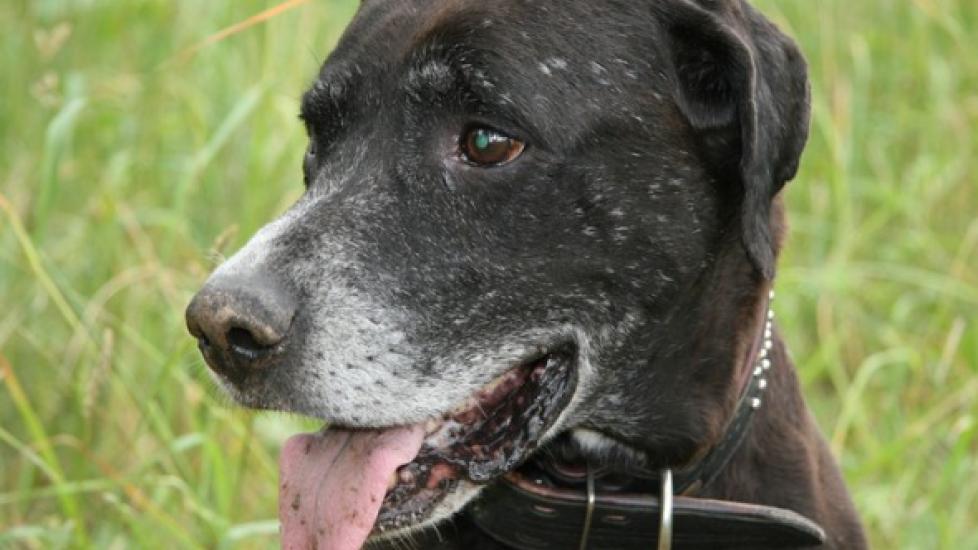7 Health Issues to Look for When You Have an Older Dog
Reviewed and updated for accuracy on May 7, 2019 by Dr. Hanie Elfenbein, DVM, PhD
All dogs get older. And like us, dogs age at different rates, especially dogs of different breeds and size.
For example, giant breed dogs like Great Danes are generally considered to be a senior by roughly 5-6 years old, whereas a smaller breed dog like a Chihuahua would probably only enter the senior stage at 10-11 years.
As your beloved dog enters his senior years, you should be prepared for certain changes that might occur in your dog’s health. Visit your veterinarian regularly; many vets recommend twice a year for senior dogs.
If you notice any of the following issues, talk to your veterinarian to determine the course of treatment.
1. Vision Loss and Other Eye Problems
Has your dog begun bumping into things, falling or displaying signs of eye discomfort (redness, cloudiness, etc.)? He may be suffering from vision loss or an eye disorder.
Deteriorating eyesight is part of the normal aging process for dogs. Many dogs will develop a cloudiness in their lens as they age, and though this is normal, it does decrease the precision of their eyesight.
Even though it may be due to aging, take your pet to the vet to rule out treatable eye diseases such as corneal damage, dry eye syndrome or conjunctivitis. Cataracts can also be treated surgically.
Loss of vision is usually irreversible, but there are certain things you can do to help your dog adjust. Ask your veterinarian for tips on handling senior dogs with vision loss.
2. Increased/Strained Urination
Increased urination or straining to urinate may be an indicator of kidney disease or urinary tract infection, both of which are more commonly seen in middle-aged to older dogs.
Fortunately, urinary incontinence and strained urination can often be alleviated with prescription dog medication or dietary changes. Urinary incontinence quickly leads to uncomfortable urinary tract infections. Consult your veterinarian if you suspect a problem.
3. Bad Breath, Bloody Gums and Other Oral Problems
If you haven’t been diligent on brushing your dog’s teeth or bringing him in to the vet’s office regularly for a professional cleaning, he’s probably beginning to display the signs of oral diseases (bad breath, excessive drooling, gum inflammation and loose teeth).
Dental hygiene, after all, is primarily about good maintenance. However, it’s not too late to start. Take your dog to your veterinarian and discuss how you can resolve the issues and prevent them from occurring in the future.
4. Lumps, Bumps and Other Skin Problems
Your dog may encounter skin and coat issues at any age, but he is more susceptible to them as he gets older. These may show up as rashes, lesions, swelling, lumps, dry skin or hair loss in dogs.
But there are often things your veterinarian can do to help alleviate the symptoms (such as make dietary changes) or even cure the underlying cause of the issue.
Many dogs develop lumps under their skin as they age. Lipomas, or fatty growths, are common and benign—meaning they pose no problem for your pet.
However, fatty growths and other more dangerous growths can look very similar, so it is best to have them evaluated by your veterinarian.
Lumps are of increased concern when they are new, when they grow, or if they change shape, color or size.
5. Weight Gain or Loss
Some older dogs have difficulty maintaining their weight and may need a dog food with a higher calorie content or better palatability, while other dogs tend to gain weight and may need a diet for less active dogs.
Neither being overweight nor underweight is ideal for your dog. Overweight and obese dogs, for instance, have a higher incidence of diseases such as diabetes, heart disease, arthritis and even cancer.
Discuss with your veterinarian when it would be appropriate for your dog to switch from an adult dog to a senior dog diet. Ask about the benefits of therapeutic diets, which can provide key benefits to help manage conditions commonly associated with aging dogs.
In addition, devise an age-appropriate exercise routine for your senior dog with the help of your vet. A proper diet and exercise plan can be important in delaying the signs of aging and increasing your dog’s longevity.
6. Difficulty Playing and Getting Around
It may be hard for you to see your previously active dog having difficulty getting around the house or playing fetch like before, but joint issues such as arthritis are common in older dogs.
Discuss with your veterinarian whether dietary changes (such as the addition of antioxidants and omega-3 fatty acids) would be helpful. Dog ramps and orthopedic dog beds can also help you accommodate your senior dog’s less-mobile state.
Physical rehabilitation can also reverse some mobility losses and is a valuable tool for aging pets.
7. Behavior and Memory Problems
Changes in your dog’s behavior may be a normal part of aging or a symptom of a disease like dog dementia (canine cognitive dysfunction).
Therefore, you need to consult your veterinarian should he exhibit signs of confusion, disorientation, memory loss, irritability, unusual pacing or other personality changes.
Some specific signs of canine cognitive dysfunction include staying awake or pacing at night, having urinary accidents and forgetting cues (e.g., sit, stay) that he once knew.
Related Articles:
Tips for Caring for Senior Dogs
5 Tips to Keep Your Senior Dog Healthy
Featured Image: iStock.com/Yury Karamanenko
Help us make PetMD better
Was this article helpful?
